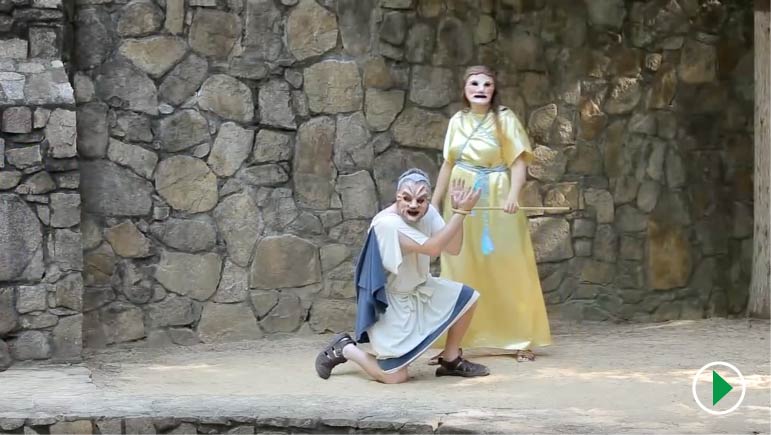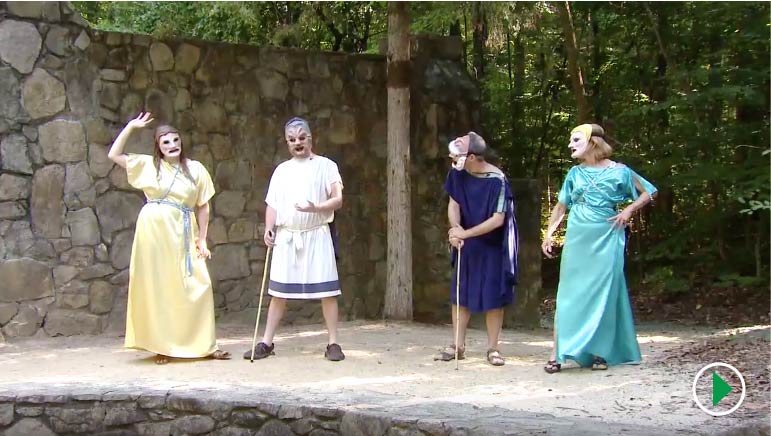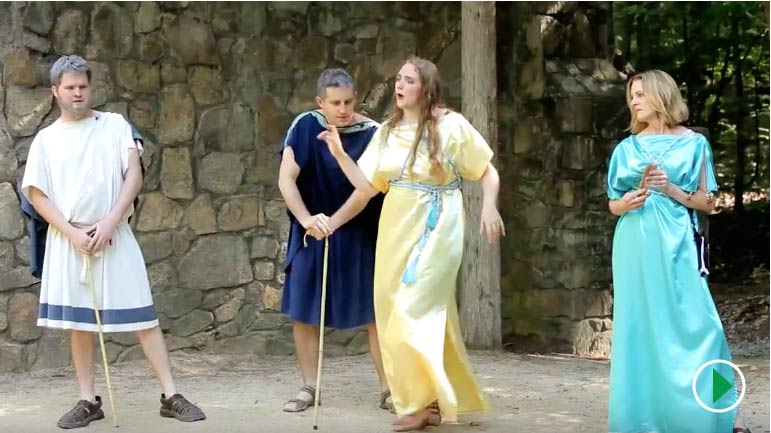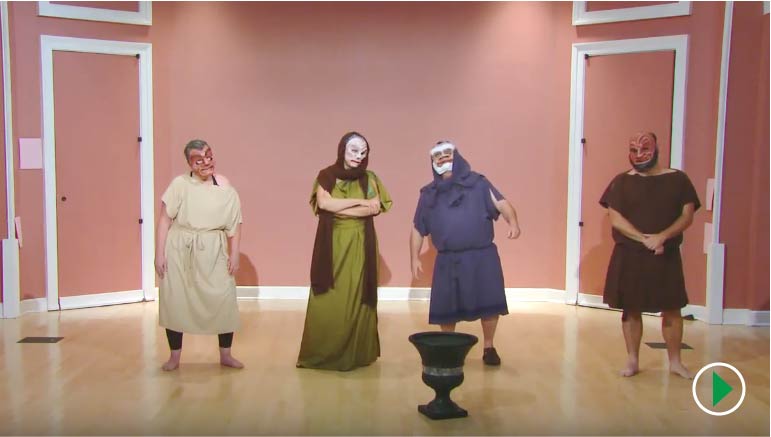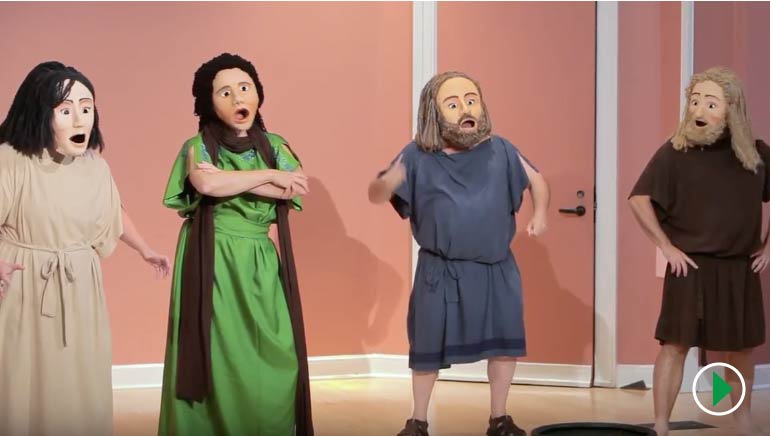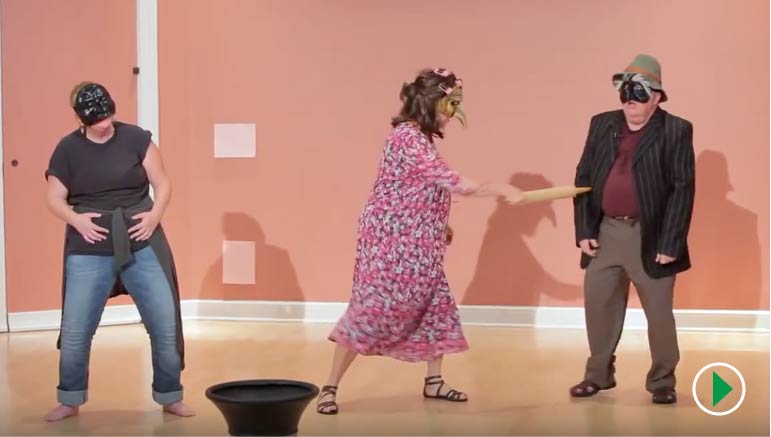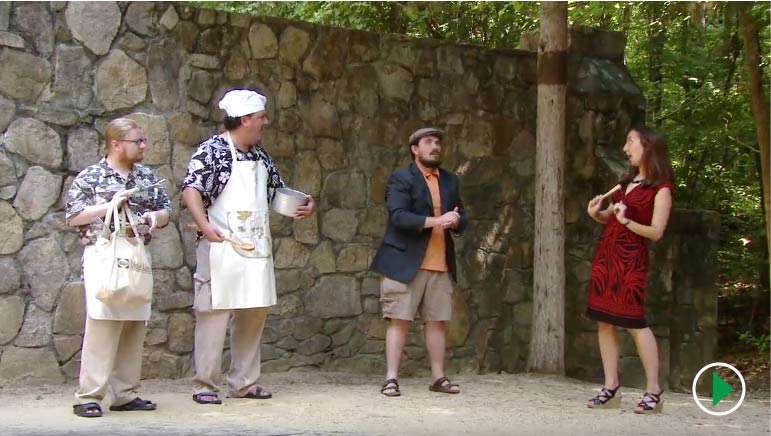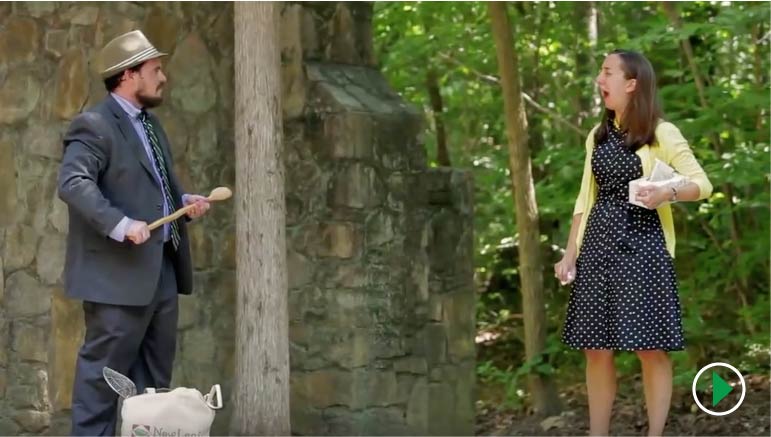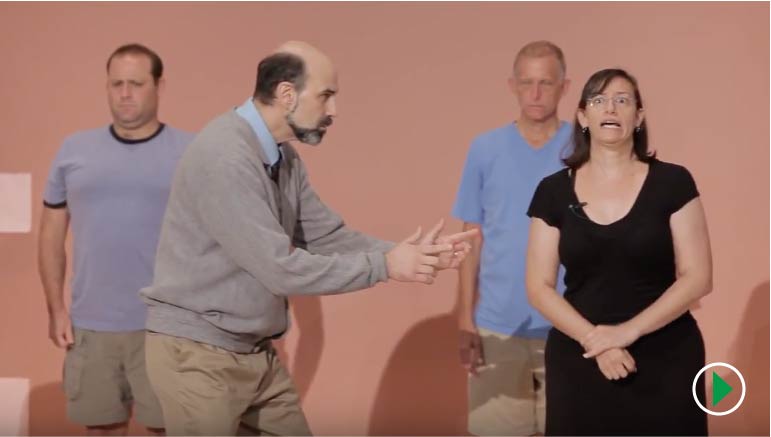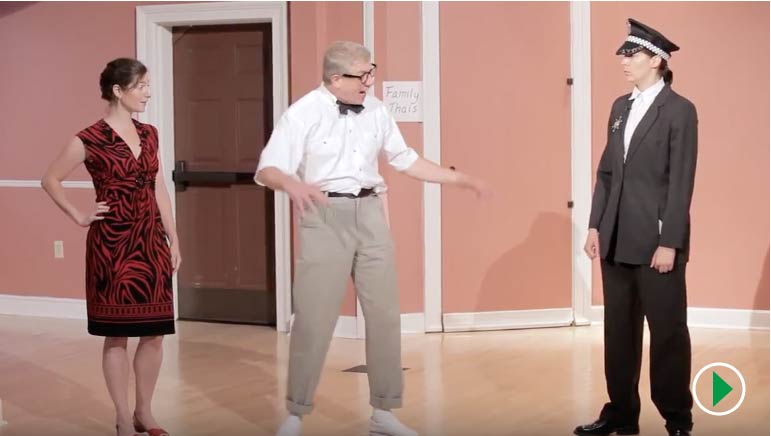Roman Comedy in Performance: Using the Videos of the 2012 NEH Summer Institute
by Timothy J. Moore (Washington University in St. Louis) and Sharon L. James (The University of North Carolina at Chapel Hill)
INTRODUCTION
In 2012 we co-directed an NEH Summer Institute for College and University Faculty at the University of North Carolina at Chapel Hill entitled, “Roman Comedy in Performance.” As part of their work in the NEH Institute, the 25 NEH Summer Scholars, divided into small groups, produced twenty performances of scenes from seven different plays of Plautus and Terence. All the performances were recorded on videos, which can be found on a dedicated YouTube Channel or via the NEH Summer Institute “Roman Comedy in Performance” Blog. Anyone interested may also purchase all the videos on two DVDs using PayPal. More information on the NEH Summer Institute, including Latin texts and English translations of each of the scenes performed and relevant bibliography, is available at the NEH Summer Institute's web site. See also the special issue of Classical Journal dedicated to the Institute (Safran and Fulkerson 2015).
Our hope in organizing the Institute was that the resulting videos would be useful for researchers, students and teachers, directors and performers, and anyone interested in Roman Comedy. Browsing the videos to see what shows up is, we think, a useful endeavor in itself. Nevertheless, the following guide should be helpful for those eager to know which videos would be most helpful for understanding specific aspects of Roman comedy and its performance. After listing the basic features of each performance, we offer suggestions as to which videos best demonstrate features of ancient performance, uses of more modern conventions, and important social issues to which the plays draw attention. We have deliberately kept our own interpretations minimal in what follows. Our purpose is not to tell viewers of the videos what to think, but to lead viewers to the videos they might find most useful for doing their own thinking about the plays.
THE PERFORMANCES
The twenty performances produced at the Institute are as follows:
I. Plautus, Pseudolus 133-234: The pimp Ballio demands that his male slaves and then his slave-prostitutes prepare for his birthday celebration. He complains that they are lazy, eat too much, and are immune to beatings (whipwasters, he calls them), then demands that each of them give him a gift, under threat of punishment. As he talks, he is striking about with a whip. Eavesdropping are young Calidorus, in love with one of Ballio’s slave-prostitutes, and his clever slave Pseudolus. When Ballio has left the stage, Pseudolus promises to trick the pimp out of the girl and to humiliate him.
Five different versions of this scene were performed at the Institute, each by a different group:1
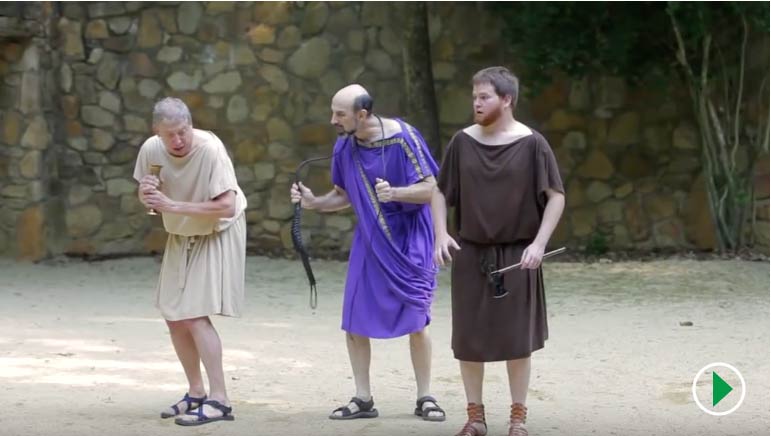
Pseudolus Group A: In Latin, with ancient-style costumes, an all-male cast (except for mutes), and background music played on a clarinet.
Performers: Christopher Bungard (Pseudolus), Amy R. Cohen (Aeschrodora), Mark Damen (slave 2), Michael Katchmer (Ballio), V. Sophie Klein (Phoenicium), Erin Moodie (Hedytium), Jeanne Neumann (Xystilis), Anthony Sprinkle (clarinet, playing music composed by T. H. M. Gellar-Goad), Daniel Walin (slave 1), Tarik Wareh (Calidorus).
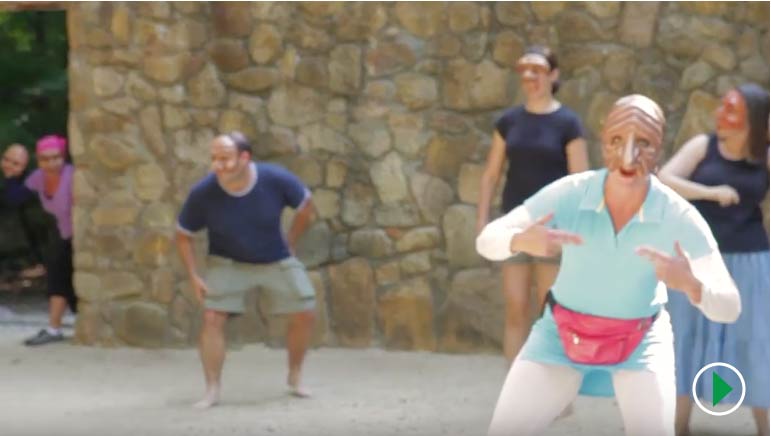
Pseudolus Group B: In English, with modern-style costumes, a heavily adapted text emphasizing physical humor, and the half masks and style of commedia dell’arte.2
Performers: Amy R. Cohen (slave 3, Candy), Angela Horchem (Ballia), Laura Lippman (Calidorus, Pseudolus), Mike Lippman (slave 2, Randy), and Erin Moodie (slave 1, Dolce)
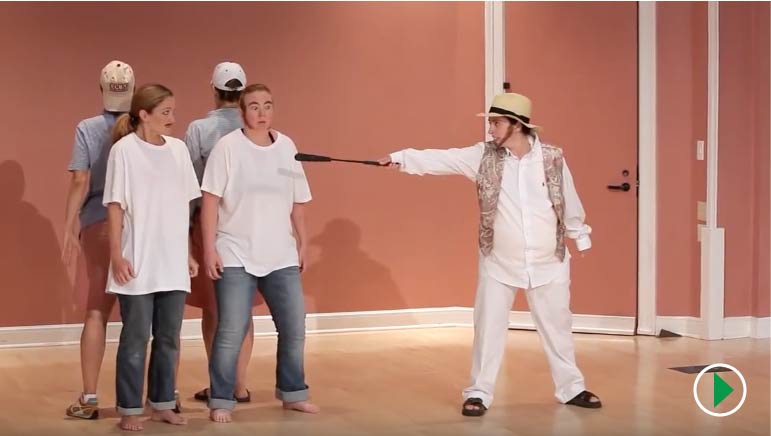
Pseudolus Group C: In English, with modern-style costumes, an all-female cast, and a “breakout scene” in which the performers discuss questions raised by the scene and its performance.
Performers: Amy R. Cohen (Fanny Fun-Bags), Angela Horchem (slave 3), Mimi Kammer (Ballio and herself), V. Sophie Klein (Violet), Erin Moodie (Sweet Tina), Jeanne Neumann (Calidorus and herself), Elizabeth Patterson (slave 1 and herself), Meredith Safran (slave 4 and herself), Nancy Sultan (slave 2, Margreasy), Chris Woodworth (Pseudolus and herself).
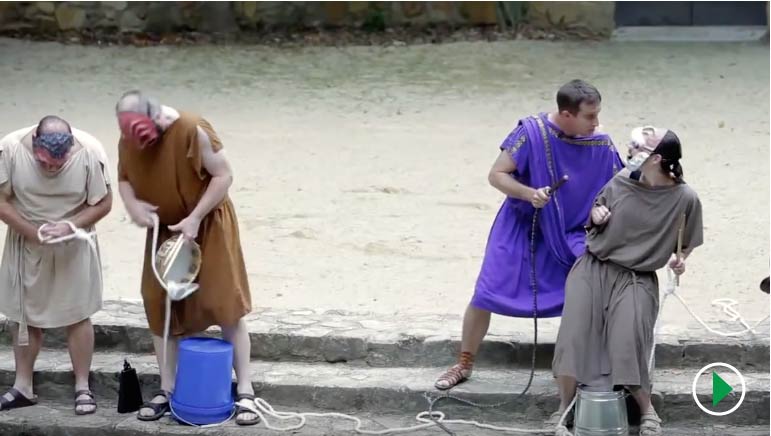
Pseudolus Group D: In English, with ancient-style costumes and some masks, in the style of hip hop, with percussion and recorder accompaniment.
Performers: Christopher Bungard (percussion), Steve Earnest (Calidorus), Patrick Gray (Ballio), Jim Hanson (slave 3, Hotlipsia), V. Sophie Klein (slave 2, Phoenicium), Mike Lippman (slave 4, Hotpantsium), Timothy Moore (percussion), Ada Palmer (recorder), Daniel Smith (slave 1, Hottitsilis), Nancy Sultan (Pseudolus).
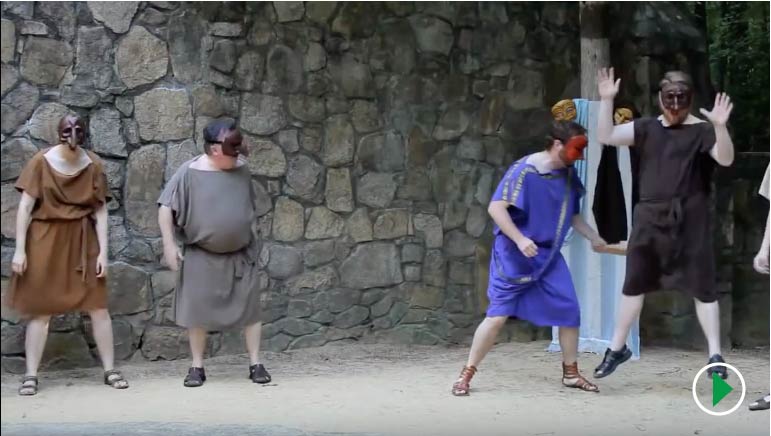
Pseudolus Group E: In English, with ancient-style costumes, some half masks as in commedia dell’arte, some full masks, and a slapstick.3
Performers: Gian Giacomo Colli (slave 2, Aeschrodora), Seth Jeppesen (Ballio), Kenneth Molloy (Calidorus, slave 3, Phoenicium), Ada Palmer (slave 1, Hedytium), Daniel Smith (Pseudolus, slave 4, Xystilis).
II. Plautus, Bacchides 1116-1206: In the play’s final scene, two old men try to storm the home of the prostitutes who have seduced their sons but are themselves seduced by the prostitutes.
One group performed this scene in three different ways, each version with these performers: Patrick Gray (Philoxenus), Jeanne Neumann (Soror), Ada Palmer (Bacchis), Daniel Walin (Nicobulus):4
II. Plautus, Casina 353-423: An old man desires that his slave, Olympio, marry Casina, the house slave of his wife, Cleostrata, so that the old man himself can rape her. Cleostrata, however, wants Casina to marry another slave, Chalinus. In this scene Cleostrata and the old man have agreed that Olympio and Chalinus will draw lots to see who will get to marry Casina. One group performed this scene in three different ways, each version with these performers: Gian Giacomo Colli (Senex), Mike Lippman, (Olympio), Elizabeth Patterson (Chalinus), Nancy Sultan (Cleostrata):5
III. Plautus, Mercator 691-802: The old man Lysimachus has agreed to let his neighbor Demipho hide a prostitute in his house and has hired a cook to provide food for them. Lysimachus’ wife, Dorippa, has returned home unexpectedly. Finding the prostitute, she assumes that Lysimachus is keeping the prostitute for himself. The cook makes things even worse for Lysimachus. One group performed this scene in three different ways:8
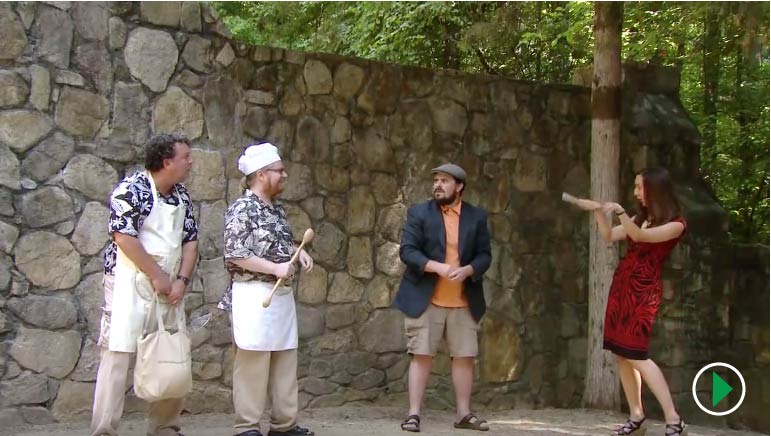
In Latin, in modern costuming: Dorippa is furious, and the cook appears to be deliberately “playing dumb” to aggravate Lysimachus.
Performers: Christopher Bungard (Lysimachus), Steve Earnest (cook’s assistant), Daniel Smith (cook), Chris Woodworth (Dorippa).
IV. Plautus, Persa 753–757, 801–858: The slaves Toxilus and Sagaristio have brought economic ruin on the pimp Dordalus through a deception. Toxilus, Sagaristio, Toxilus’ slave girlfriend Lemniselenis (previously owned by Dordalus) and their fellow slave Paegnium ruthlessly mock Dordalus as the play ends. This scene was performed in one version, by Amy R. Cohen (Toxilus), Angela Horchem (Sagaristio), Seth Jeppesen (Paegnium), Mimi Kammer (Lemniselenis), Tony Sprinkle (clarinet, performing music composed by T. H. M. Gellar-Goad), Tarik Wareh (Dordalus):9
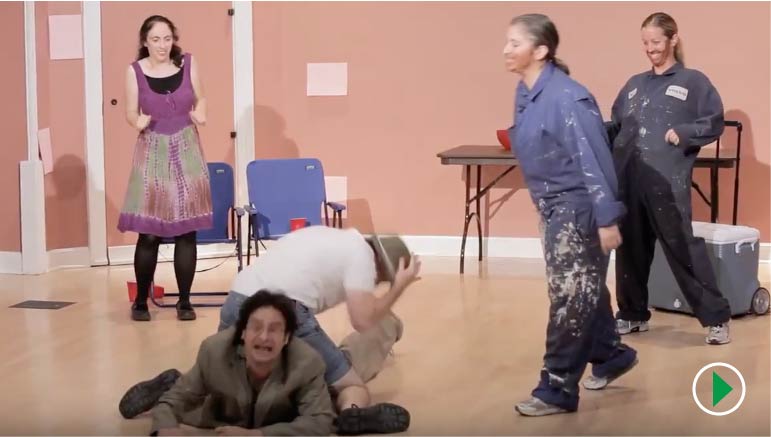 |
| In Latin, in modern costuming, sung to the unison accompaniment of a clarinet. |
V. Plautus, Truculentus 775-854:
Diniarchus has impregnated the daughter of Callicles. When the girl and her mother wanted to conceal the birth they gave the baby to one of their slaves, who handed it over to a slave of the prostitute Phronesium. Phronesium has been pretending the baby is hers by one of her lovers, in order to win gifts from him. Callicles has found out about the ruse and brutally interrogates the two slaves, while Diniarchus eavesdrops. One group performed this scene in two different ways:10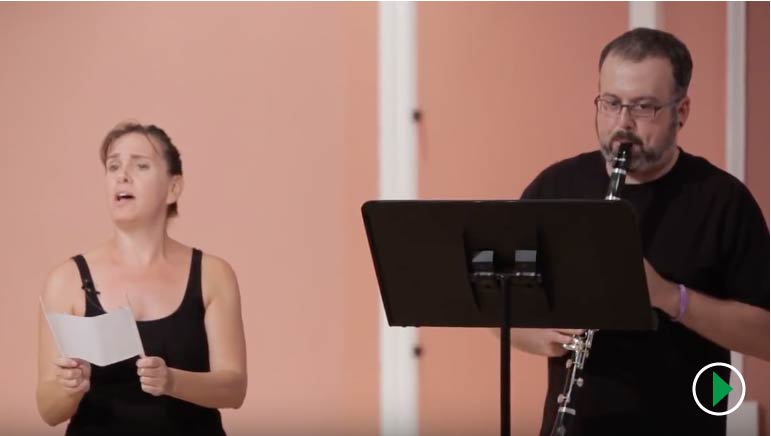
In Latin, in modern costumes, sung with a repetitive melody to the unison accompaniment of a clarinet, in the style of melodrama.
Performers: Jim Hanson (Diniarchus), Michael Katchmer (Callicles), Laura Lippman (Phronesium’s ancilla), Mike Lippman (lorarius 1), Timothy Moore (lorarius 2), Meredith Safran (Callicles’ ancilla); Tony Sprinkle (clarinet, performing music composed by T. H. M. Gellar-Goad).
VI. Terence, Eunuchus 739-816: The prostitute Thais has used one of her lovers, the braggart soldier Thraso, to obtain custody of the citizen girl Pamphila, who was captured by pirates. Thais wants to return Pamphila to Pamphila’s brother, Chremes. Thraso, thinking that Chremes is Thais’s lover, comes with his parasite Gnatho and several of his slaves to try to force Thais to give him back Pamphila. One group performed this scene in three different ways:11
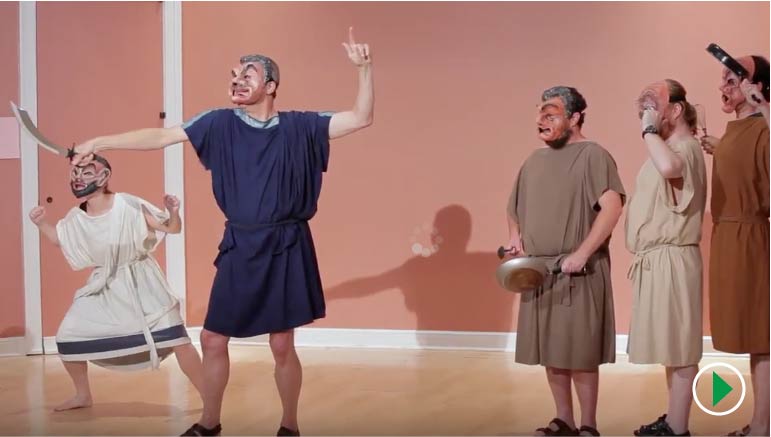
In Latin, in masks and ancient-style costumes, with elaborate, stylized gestures.
Performers: Christopher Bungard (Simalio), Amy R. Cohen (Pythias), Mark Damen (Thraso), T. H. M. Gellar-Goad (voice of Pythias), Seth Jeppesen (Sanga), V. Sophie Klein (Gnatho), Kenneth Molloy (Chremes), Erin Moodie (Thais), Daniel Smith (Donax), Tarik Wareh (Syriscus).
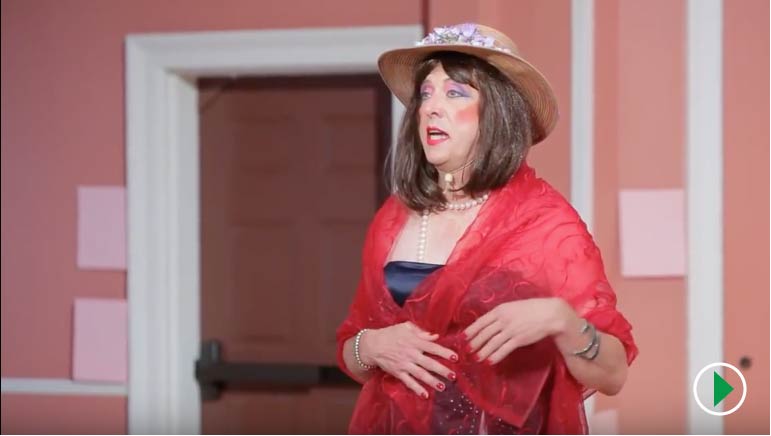
In English, using Henry Thomas Riley's 19th-century translation, with costumes suggesting a Victorian garden party.
Performers: Christopher Bungard (Simalio), Amy R. Cohen (Pythias), Mark Damen (Thais), Seth Jeppesen (Sanga), V. Sophie Klein (Chremes), Kenneth Molloy (Gnatho), Erin Moodie (Thraso), Daniel Smith (Donax), Tarik Wareh (Syriscus).
GLIMPSING FEATURES OF ANCIENT PERFORMANCE
As is the case with any theatrical work, features of performance contribute much to the meaning and effect of Plautus's and Terence’s plays. Many aspects of performance in the Roman republic can be captured, even if exact recreation of ancient performance practice is beyond our reach (see Marshall 2006). The NEH Summer Scholars therefore spent a great deal of time studying the conditions of performance in second-century-BCE Rome, and many of the videos are useful tools for those pondering what Roman comedy’s original audiences might have experienced.
Language
Five of the performances are in Latin:
The Latin version of Pseudolus 133-234 offers viewers the chance to hear some of Plautus’ most exuberant Latin. Note such verses as Ballio’s string of two-syllable commands to his slaves:haec, quum ego a foro revortar, facite ut offendam parata,
vorsa sparsa, tersa strata, lautaque unctaque omnia uti sint.See to it that when I come back from the forum I find all these things done, swept, spread, polished, strewn, washed and anointed (163-4, 4:53 on the video);12
the wordplay as Pseudolus and Calidorus respond to Ballio’s threats against his slave prostitutes:
CALIDORUS. audin, furcifer quae loquitur?
satin magnificus tibi videtur?
PSEUDOLUS. pol iste, atque etiam malificus.
sed tace atque hanc rem gere.CALIDORUS. Do you hear what that scoundrel is saying? You think he’s boastful enough?
PSEUDOLUS. He sure is, and badful too. But be quiet and pay attention to this. (194-195a, 10:38 in the video);
and the over-the-top threats Ballio makes against the prostitutes, including this one:
Aeschrodora, tu quae amicos tibi habes lenonum aemulos
lanios, qui, item ut nos iurando, iure malo male quaerunt rem, audi:
nisi carnaria tria gravida tegoribus onere uberi hodie
mihi erunt, cras te quasi Dircam olim, ut memorant, duo gnati Iovis
devinxere ad taurum, item ego te distringam ad carnarium; id
tibi profecto taurus fiet.Aeschrodora, whose lovers are butchers, who imitate pimps: we make our money with bad oaths, they make theirs with bad soup. Listen up: unless I get three meat racks today, loaded down with big fat hides, tomorrow I’m gonna string you up on a meat rack, just like in the story, when the two sons of Jupiter tied Dirce to a bull: the meat rack’s gonna be your bull. (196-201, 10:53 in the video).
The Latin version of Bacchides 1161-1206 offers such gems as the onomatopoetic comparison of the old men to sheep by one of the prostitutes:
pastor harum
dormit, quom haec eunt sic a pecu balitantes.Their shepherd is asleep, while these go off baahing in this way away from the flock (1122-1123, 0:39 in the video);
and Nicobulus’ alliterative description of the women:
eunt eccas tandem
probri perlecebrae et persuastrices.Look at them coming at us, wicked, seductive enchantresses (1166-1167, 5:07 in the video).
The Latin version of Mercator 691-802 is the scene in which Latin students and others who know some Latin are likely to “catch” the most words. Particularly effective pedagogically will be the frequent cases of verbal repetition like the following:
LYSIMACHUS. vidistine eam?
DORIPPA. vidi. LYS. quoia ea sit rogitas? DOR. resciscam tamen.
LYS. vin dicam quoiast? illa— illa edepol— vae mihi!
nescio quid dicam. DOR. haeres. LYS. haud vidi magis.LYS. Oh—you saw her?
DOR. I SAW HER!
LYS. You want to know whose she is?
DOR. You know I’m going to find out!
LYS. Do you want me to tell you whose she is? She’s—um, um,
she’s—oh God!
I don’t know what to stay.
DOR. Cat got your tongue?
LYS. No!
(720-723, 2:14 in the video).
COCUS. nempe uxor rurist tua, quam dudum deixeras
te odisse [aeque] atque anguis. LYSIMACHUS. egone istuc dixi tibi?
COC. mihi quidem hercle. LYS. ita me amabit Iuppiter,
uxor, ut ego illud numquam dixi. DORIPPA. etiam negas?
palam istaec fiunt, te me odisse. LYS. quin nego.
COC. non, non te odisse aibat sed uxorem suam;
et uxorem suam ruri esse aiebat. LYS. haec east.COOK. No, but your wife is off in the country, the one you said
you hate like a snake.
LYSIMACHUS. I said that to you?
CO. You sure did, to me.
LYS. Wife, so may Jupiter love me,
I never said that!
DORIPPA. You’re still denying it? It’s becoming
public that you hate me.
LYS. No, I don’t!
CO. No no, he didn’t say he hated you—it’s his wife he hates. And he said she’s off in the country.
LYS. This is my wife!
(760-766, 5:06 in the video)
Toxilus opens the Latin performance of Persa 753–757 and 801–858 with a string of ablative absolutes parodying Roman triumph language:
hostibus victis, civibus salvis, re placida, pacibus perfectis,
bello exstincto, re bene gesta, integro exercitu et praesidiis,
cum bene nos, Iuppiter, iuvisti, dique alii omnes caelipotentes,
eas vobis habeo grates atque ago, quia probe sum ultus meum inimicum.
nunc ob eam rem inter participes dividam praedam et participabo.Enemies: defeated. Citizens: safe. State: at peace. Treaties: completed. War: over! This campaign has come to a successful conclusion, and the army and the garrison are intact. Jupiter, you and all the other gods, masters of the heavens, helped our efforts generously, so I feel grateful to you, and I give you my thanks. I really gave my enemy what he deserved! So I will now divide up my booty and share it with my comrades in arms. (753-757, 0:17 in the video)
Space
Ten of the Institute’s scenes were performed outdoors in the University of North Carolina’s Forest Theater, ten indoors in Gerrard Hall on the same campus. Neither of these spaces recreated the theater space of Plautus and Terence’s Rome, but both captured some features of that space.
The Forest Theater mimics a Greek theater: it is an outdoor semicircle of stone seats. Stage and orchestra do not match exactly what is found in most Greek theaters, but there is some playable space between the seating and the raised stage, which is deep and wide with two wings and a back wall with three doors. The Roman theaters of the mid-Republic were different in many ways from what we think of when we envision Greek theaters: they were probably much smaller and consisted usually of temporary stages constructed in front of temple steps or similar locations where spectators could sit.13 Those theaters were, however, outdoors, like Greek theaters and the Forest Theater. Each performance in the Forest Theater therefore captures an important element of ancient performance, with natural lighting, ambient sound, and limited barriers between actors and spectators.
The width of the stage in the temporary theaters of Plautus and Terence’s day probably varied considerably from venue to venue. The NEH Summer Scholars’ use of different parts of the Forest Theater’s stage is therefore instructive. The Latin Pseudolus and the hip-hop Pseudolus made use of the full wide stage of the theater. The commedia dell’arte Pseudolus, on the other hand, was performed using just a part of the central stage area of the theater; and all versions of Mercator and Bacchides as well as the slapstick Pseudolus were performed on one of the stage’s projecting wings. One notes in the two scenes using the full stage the distance between eavesdroppers and those they listen to, and the ability for the performers to introduce grand processions and tableaux. When just two or three actors inhabit the full stage, as in the opening and closing moments of the Pseudolus scene, one senses the challenge the actors had in not being swallowed up by their surroundings. The greater intimacy of the scenes performed on only part of the stage is striking. Here eavesdroppers stand close to those they listen to, movement can be equally lively but must be limited in the distance it covers, and the challenge becomes not filling the stage in scenes with few actors but fitting all the performers in comfortably in scenes with four or more on stage. The various Forest Theater scenes taken together are thus “good to think with” for those pondering the kinds of challenges varying spaces would provide to the theatrical troupes who performed Plautus and Terence’s plays in Republican Rome.
Gerrard Hall, a large open indoor space, is far removed from the theaters at which Plautus and Terence were first performed. It does, however, share an important feature with the backdrop for Roman comedy: each of the scenes performed in Gerrard Hall used a side of the hall that has two symmetrically placed doors. Performers could thus recreate the street scene in front of two houses that was the standard setting for Roman comedies. In fact, in only two scenes did the NEH Summer Scholars choose to enter through one of the two doors: in both the Latin and English versions of the Truculentus scene Callicles leads the slaves he is interrogating and his lorarii (henchmen) onto stage from the door on stage left. This is an interesting interpretive choice, as it suggests that Dinarchus’ victim, Callicles’ daughter, lives in a home across the stage from his paramour, Phronesium.14
In the other productions the performers ignored the doors, but the presence of the doors in the backdrop is nevertheless significant for those who know the play. The Persa scene is a party with tables and drinks, a helpful reminder of Roman audiences' comfort in accepting that on-stage events normally held indoors occur outside. As husband, wives, and slaves vie for the possession of Casina in the various versions of the Casina scene, they do so in front of her home and the home where the old man will try to rape her; even without an explicit reference to the houses, the presence of the doors is a reminder of what is at stake. Thraso’s attempt to keep Thais away from Chremes in Eunuchus occurs in front of her home and that of Thais’s lover, Phaedria. The doors in the background thus bring irony and humor, as Thraso attempts to thwart an assumed rival right in front of the house of his real rival and the house of a prostitute becomes an impregnable fortress to the soldier and his cronies.
Masks
In nine of the performances some or all of the characters wore masks. Varieties in the types of masks and how they are used shed much light on what masked performance may have been like in Rome and how masks work in general. The masked scenes demonstrate how masks suit large and stylized movements, how they can both support and undermine character attributes suggested by the text, and how different kinds of masks produce markedly different effects.
Adam M. Dill created a set of papier-machè masks for the NEH Summer Scholars to use. Dill did not try to recreate ancient masks with precision, but he studied the visual and literary evidence for masks and made masks reminiscent of those, representing thirteen different stock comic types: two old men, an old woman, a young lover, a pimp, a clever slave, four other slaves, and three meretrices ranging from grasping to innocent. The masks of the Latin version of Eunuchus lent themselves well to the scene’s heavily stylized performance with marked frontality. The masks also showed how mask styles can contribute to characterization but do not determine character in themselves. Thais wore a meretrix mask that lacked both the worldly features of the “grasping meretrix” mask and the innocence of the “pseudo-meretrix” mask. Her mask thus helped the audience appreciate that she transcends the stereotypes usually associated with prostitutes in Roman comedy. Gnatho’s mask was intended as a pimp’s mask, but with his large ears, raised eyebrows, and pointy chin, it fit well the sleaziness of this parasite. Thraso’s mask, uncannily reminiscent of Richard Nixon, was designed as a slave’s mask, but it nevertheless suited the soldier’s bluster well.
Thraso’s mask also had a raised eyebrow on its left side, a lower eyebrow on the right. This design was inspired by a description of such a mask by Quintilian (11.3.74). Conspicuously asymmetrical masks were worn not only by Thraso and Sanga in this scene, but also by “slave 3” (the one playing percussion on the blue bucket) and “slave 4” (playing the tambourine) in the hip-hop Pseudolus, and by Olympio in one of the Casina scenes. Viewers will want to decide for themselves if, as Quintilian claims, the actor wearing such a mask shows different moods by turning one side of the mask or the other towards the audience.
One version of the Institute’s Casina scene used Dill’s masks. Here one notes how masks can both reinforce character and produce irony. The mask of Chalinus, who is virtuously helping his mistress, looks much less sinister than that of Olympio, involved in his master’s reprehensible schemes. But the ugliness of the old woman’s mask contradicts the character of Cleostrata, who will gain the audience’s sympathy as the play proceeds.
In the two versions of Bacchides (English and Latin) performed with masks, the difference between the smooth loveliness of the meretrices’ masks and the grotesqueness of the old men’s is striking. One of the most effective ways to appreciate the effect of masks is to watch the English masked version and then the English unmasked version of the same scene from Bacchides. The masks do not prevent a rather naturalistic mode of performance on the part of the actors. Their presence in the masked scene nevertheless calls attention to the actors as stock types in a way that is not as evident in the unmasked scene. Another way of appreciating the difference is to watch the hip-hop Pseudolus scene. Here the speaking characters—Ballio, Calidorus, and Pseudolus—are unmasked, but Ballio’s largely silent slaves, both male and female, wear masks. On the one hand, the masks help distinguish individuals from types. Yet at the same time, one is struck with the degree to which the masked slaves can show individuality even as they reveal no facial features and speak few or no words.
Four of the scenes used masks other than those made by Dill. For the three scenes using commedia dell’arte masks, see below. The group performing Casina showed how different types of masks affect performance by presenting their scene both in Dill’s masks (see above) and with much larger masks designed by Amy R. Cohen for performances of Greek tragedy. Ironically, the larger masks, though intended for tragedy, contributed significantly to the humor of the scene in which they were used. For in the small space of Gerrard Hall and in a comic context the exaggerated features of the tragic masks look ridiculous.
Music
In the original performances of Plautus and Terence, actors sang extensive portions of each play to the accompaniment of the two-piped tibia (Moore 2012). The NEH Summer Scholars had no tibiae, but four of the performances sought to recreate some aspects of republican Roman musical theater.
The group of NEH Summer Scholars performing the final scene of Plautus’ Bacchides in Latin sang a cappella, using simple melodies created by one of the performers (Ada Palmer), one melody for each type of meter used in the scene. This method of performance, easily recreated in the classroom (cf. Moore 2012/13), allows spectators to appreciate clearly the effects of metrical changes and imitates the close connection between meter and melody that was probably in evidence in the play’s original performances.
Three scenes incorporated a clarinet:15 this modern instrument is in many ways vastly different from the tibia, which had not only two pipes but double reeds as opposed to the clarinet’s single reed. The clarinet is, however, a woodwind instrument like the tibia, so its presence captured something of the Roman experience. The performers of the Latin Pseudolus scene spoke their verses while the clarinetist played accompaniment rhythmically independent of what the actors were doing but changing melodic patterns in response to what was happening on stage. The effect was closer to that of modern film music than to Roman theater, but the changing tunes of the clarinet nevertheless recreate an element of what happened on the Roman stage, where meter, and with it melody, changed in response to mood, character, and other factors.
In two scenes the actors sing in unison with the clarinet. Although in republican Rome the tibicen probably did not play in unison with the singers, these productions come closest to recreating what probably happened on the Roman stage, where actors and instrumentalist cooperated closely. The most elaborate musical performance in the videos is the ending of Plautus’ Persa, which features a widely varied melody sung to the unison accompaniment of a clarinet. This scene can give students and others a good idea of just how elaborate the music of Roman comic performance could be. The most jarring scene musically for a modern audience is the Latin Truculentus. The scene is entirely in trochaic septenarii, and the singers and clarinetist produce the same melody, with slight variations, as they deliver each of the scene’s 80 verses. The result sounds oddly repetitive and exotic to most modern listeners, but our evidence suggests that accompanied stichic scenes may have been performed with just such repetitive melodies (Moore 2012, 141): Roman audiences were more attuned than we are to the slight rhythmic and melodic variations that occur from verse to verse.
Movement
Each of the scenes incorporates gesture and movement. Several provide especially effective suggestions regarding what movement on the Roman stage might have been like. The performers of the Latin Eunuchus used elaborate, large and stylized gestures. Most of the other scenes used more naturalistic movement. Our evidence does not allow us to say where Roman comedy lay on this spectrum (cf. Marshall 2006, 167), so it is useful for students and scholars to see both possibilities. Performances such as the Latin Bacchides and the masked English Bacchides scenes demonstrate the possibility of lively movement and dance in masks and flowing costumes. The rollicking physical humor of the commedia dell’arte Pseudolus scene and the aggressive struggles of the three Casina scenes raise still more possibilities.The Persa scene includes “cinaedic dancing”: a kind of lewd dance used by Plautus to underline his most Saturnalian moments, like this one in which slaves humiliate a free person. We have insufficient evidence for the exact movements used in cinaedic dancing, but the NEH Summer Scholars who performed this scene surely have captured its spirit in the slaves’ lewd mockery of the pimp Dordalus.
USING MODERN CONVENTIONS
The NEH Summer Scholars, while eager to echo elements of ancient performance, did not intend for their productions to be museum pieces. Each of the scenes employs modern techniques as well, and several of the performing groups made a special point of using conventions drawn from specific modern performance traditions.
Three scenes draw from commedia dell’arte, an appropriate choice, as Roman comedy, especially Plautus, has often been compared to commedia dell’arte in its use of broad farce, stock characters, and apparent—if not actual—improvisation.
The group performing the slapstick Pseudolus presented slaves not cowering like those of the Latin Pseudolus, but mocking their master Ballio behind his back. The conventions of commedia dell’arte, with its frequent scenarios of servants over masters, were especially suitable for this interpretation of the scene. The slave-prostitutes in the slapstick Pseudolus wore ancient-style masks designed by Dill, but all the male characters wore the half masks of commedia dell’arte, provided by Gian Giacomo Colli. And Ballio’s slapstick, a prop with a long pedigree in commedia dell’arte, called attention to the frightening nature of Ballio’s threats with its loud cracks even as it emphasized that those threats were not real but a theatrical phenomenon.
The performers of the commedia dell’arte Pseudolus scene embraced the traditions of commedia dell’arte more thoroughly. All the characters wear the half masks of commedia (made by Angela Horchem); the scene is filled with lively comic movement typical of commedia; and the translation, while not improvised, includes series of jokes reminiscent of commedia’s improvised joke scenes.
In performing yet a third masked version of Casina, the group performing this scene went a step further. They not only used commedia-style half masks (made by Gian Giacomo Colli) and boisterous movement, but they treated Plautus’ text as a scenario, from which they improvised as a commedia dell’arte troupe would.
Other scenes incorporated theatrical conventions developed in the nineteenth and twentieth centuries. The 19th-century Eunuchus used the Victorian translation of Henry Thomas Riley and costuming to suggest a Victorian garden party. We get to see how a Terentian scene might look in the world of Trollope. Mid-twentieth–century melodrama inspired the English Truculentus scene. Both diction and gestures are exaggerated, and the NEH Scholars wrote a suspense-filled prologue and epilogue, in which dark chords from a piano emphasize significant moments. Such overblown performance, almost inevitably laughable in our day, helps reconcile a modern audience to the scene’s mixture of serious subject matter and comic context.
The hip-hop Pseudolus employs ancient-style costumes but the language and rhythmic patterns of hip hop. Hip hop brings a kind of rhythmic repetition similar in some ways to what we find in the stichic portions of Roman comedy, although, unlike Roman comedy, it relies on a steady “beat.” More importantly, hip hop, like Roman comedy, relies on a popular musical style that has not lost its potential for subversion even as it has become part of mainstream culture.
Television inspired two of the NEH Scholars’ scenes. One of the English versions of the Mercator scene uses costumes modeled on the popular series “Mad Men.” The allusion to that series, with its early-1960s gender dynamics, brings extra power to this version, in which Dorippa is mournfully put upon.
The NEH Summer Scholars performing Terence’s Eunuchus produced an adaptation of the scene as a 21st-century sitcom. The adaptation calls attention to how much has changed in comedy since the second century BCE. Gone are the prostitute (Thais becomes an accountant for an escort service), slave, and parasite characters, and a new set of conventions such as a laugh track and repeated one-liners dominate the performance. The same performance, however, shows how much has remained the same. The sitcom, like its Roman ancestors, relies on stock characters (a “dorky” brother, an arrogant but stupid policeman, and his clueless assistant), and issues of status remain central (here the characters discuss Pamphila’s citizenship rather than whether she is slave or freeborn).
SOCIAL ISSUES
Roman comedy is fascinating both for students of ancient Rome and for those who appreciate good drama in part because of its complex response to social issues endemic in Rome and still relevant today, especially those surrounding gender and social class. Gender and class play important roles in each of the scenes performed at the NEH Institute. We point out here some of the scenes where those issues most come to the fore.
Slavery
Slaves are at the heart of all Roman comedies. The final scene of Persa shows most clearly how Roman comedy can provide an escape in which slaves can lord it over a free person. At the same time, issues of social status are not simply forgotten: the scene includes a surprising discourse by a slave on the arrogance of freed persons (lines 838ff.: 6:53 ff. in the video). The Pseudolus scenes, as we have seen, show varying reactions of slaves to a master’s threats, ranging from cowering in the Latin Pseudolus to insouciant mockery in the slapstick and commedia dell’arte versions of the same scene.
Roman comedy offers far more than an escape from social hierarchies, however. Reminders of the subservience of slaves are everywhere. Note the slaves of the Casina scene in each of its versions, who must obey their master and mistress even as they flaunt their alleged power over each other. Most telling of all for one seeking to appreciate the power of slavery in Roman society is the scene Institute Scholars performed from Truculentus. Here two slaves have just come from being tortured. Though one of the slaves does not even belong to the torturer, they continue to be abused throughout the scene. Significantly, the scene is not about the torture of the slaves: they are just a means through which the rape and pregnancy of an absent free woman are revealed. Hence the scene’s double focus, evident in both the Latin and English versions, on the eavesdropping Diniarchus and Callicles abusing the two slaves. Diniarchus is allegedly at the center of the comic plot, but the treatment of the slaves inevitably draws the attention of a modern spectator.
Gender
The all-female Pseudolus performers took on the gender issues of Roman comedy most emphatically. The performance of all the characters by women—in contrast to the all-male casts of republican Rome—brings its own frisson. Taking advantage of this, the performers interrupted their performance midway through Ballio’s abuse of his sex slaves with a “break-out scene” in which they discuss the various issues that come with performing Roman comedy (e.g., “Does dolling ourselves up in drag really subvert the normative heterosexual flow of desire in this scene, or are we just creating some kind of spectacle to distract from the totally disturbing nature of the material?”).
Each of the other Pseudolus scenes likewise provides food for thought about the sexual exploitation of women, both in ancient Rome and today. In the Latin Pseudolus the sex slaves are veiled: as they passively endure Ballio’s abuse, they cannot even express their reactions through facial expressions or the expressiveness encouraged by masks. Each of the other Pseudolus scenes underlines gender differences by contrasting passive female sex slaves with more assertive male slaves. In the hip-hop Pseudolus the male slaves take far more musical initiative than do the women. In the slapstick Pseudolus the male slaves, in half-masks, mock Ballio behind his back. The female sex slaves, in full masks, are much more active than in any of the other NEH Institute’s versions of this scene: they respond with lively gestures and wordless utterings to Ballio’s commands and threats. They do not, however, resist him or make fun of him when he is not looking as their male counterparts do.
The Institute’s three versions of Mercator reveal most clearly how performance can determine how audiences might respond to gender relations in comedies. In one of the English versions of the scene, Dorippa is tearful and in despair. In the other English version and the Latin version, she reverses the power dynamics with an angry rebuke of her husband. Significantly, in neither version does she come off as simply an unsympathetic shrew.
Lording it over her husband in the version where she is angry, Dorippa shows that the inversion of everyday social hierarchies we see in many of Roman comedy’s slaves can also apply to its women. Still more powerful inversions of standard gender hierarchy occur in the three Bacchides scenes, as two meretrices seduce the old men who threaten to beat them, and in the Eunuchus scenes, where the meretrix Thais looks on as the solder Thraso makes a fool of himself. In the scene performed from Casina, however, the inversion has not yet occurred, and Cleostrata, still subservient to her husband, must use her slave against his slave as she tries to counter him.
CONCLUSION
The videos of the NEH Summer Institute on Roman Comedy in Performance thus have much to offer to anyone interested in ancient or modern dramatic performance, Roman comedy, or Roman society. It is hoped that this guide will help readers find scenes that are most useful for their own interests. The videos, however, are rich in more ways than can be expressed here. We encourage readers to peruse the videos to find further insights, and also to do some performing of their own. As these videos show, performance is one of the most effective ways of discovering just what is going on in these delightful yet often enigmatic comedies.
notes
1 Pseudolus participants discuss their work on these videos in a talkback available on YouTube and collected with talkbacks on all the scenes in Didaskalia, Volume 12, Number 7.
2 The masks were made by Angela Horchem and are used in the commedia dell'arte performances and education outreach of theater 3 in Tucson, Arizona.
3 Masks provided by Gian Giacomo Colli.
4 Bacchides participants discuss their work on these videos in a talkback available on YouTube and collected with talkbacks on all the scenes in Didaskalia, Volume 12, Number 7.
5 Casina participants discuss their work on these videos in a talkback available on YouTube and collected with talkbacks on all the scenes in Didaskalia, Volume 12, Number 7.
6 The masks were produced by Amy R. Cohen and are used in the performances of Greek plays she directs regularly at the Center for Ancient Drama at Randolph College.
7 Masks provided by Gian Giacomo Colli.
8 Mercator participants discuss their work on these videos in a talkback available on YouTube and collected with talkbacks on all the scenes in Didaskalia, Volume 12, Number 7.
9 Persa participants discuss their work on this video in a talkback available on YouTube and collected with talkbacks on all the scenes in Didaskalia, Volume 12, Number 7.
10 Truculentus participants discuss their work on these videos in a talkback available on YouTube and collected with talkbacks on all the scenes in Didaskalia, Volume 12, Number 7.
11 Eunuchus participants discuss their work on these videos in a talkback available on YouTube and collected with talkbacks on all the scenes in Didaskalia, Volume 12, Number 7.
12 All translations are by one of the authors.
13 See Marshall 2006, 36-48 and the works cited there.
14 The text of the play as a whole suggests that if there were just two doors on stage they represented the homes of Phronesium and Strabax. In three scenes—the two versions of Truculentus and the all-female Pseudolus—characters enter or exit through the doors further to the right or left: these are virtually equivalent to the side entrances or exits that occurred frequently in Roman performances.
15 In each scene the melodies played by the clarinetist and sung by the actors were composed by T. H. M. Gellar-Goad. Scores are available from him upon request (tedgellar@gmail.com).
works cited
Marshall, C. W. 2006. The Stagecraft and Performance of Roman Comedy. Cambridge.
Moore, T. J. 2012. Music in Roman Comedy. Cambridge.
Moore, T. J. 2012/13. “Don’t Skip the Meter! Introducing Students to the Music of Roman Comedy.” Classical Journal 108: 218-234.
Safran, Meredith, and Laurel Fulkerson (eds.). 2015. Special Issue on Plautus in Performance. Classical Journal 111.1: 1-132.

